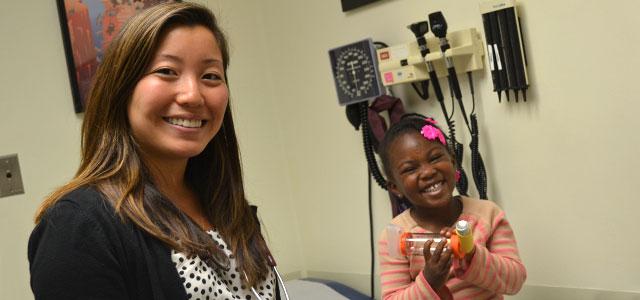
Kimberlee Honda, director of San Francisco General Hospital’s Pediatric Asthma Clinic.
What Preceptors Do: Kimberlee Honda and the Pediatric Asthma Clinic
Volunteer clinical faculty and preceptors offer students individual perspectives and hands-on experience in a variety of health care settings and specialties. The cumulative effect of what these volunteers impart plays a significant role in the care any health system delivers. This series aims to shed light on the unique roles these valuable mentors play.
This month, we hear from Kimberlee Honda, family nurse practitioner and clinic director of the Pediatric Asthma & Allergy Clinic at San Francisco General Hospital.
I graduated from the UC San Francisco Master’s Entry Program in Nursing (MEPN) in 2008 after working for a few years in community health. After college, I had planned to apply to medical school and moved to Berkeley as an AmeriCorps Community HealthCorps volunteer, hoping for a taste of different types of medicine in the community setting. I met midwives and nurse practitioners (NPs) for the first time, and when I saw the work they were doing, I started to warm up to the idea of nursing. The MEPN program was ideal for me because it was accelerated and carved out a clear path toward community health.
My first job after finishing my master’s was in full-time family practice at Community Health Clinic Ole. As the only community health clinic in Napa, Clinic Ole occupies a unique niche caring for the underserved population in Napa – predominantly monolingual, Spanish-speaking farmworkers. Working there helped me solidify my clinical skills because I managed a variety of medically complex patients. But it also helped me begin to develop my identity as an NP, to take on the responsibility of caring for families over time and to experience this in the community setting. I feel like I grew along with my patients as I got to know them, which was a tremendous honor.
After three years in practice, I started to think about exploring other roles NPs could fulfill, and I saw a posting for a job as assistant clinic director at the Pediatric Asthma Clinic at San Francisco General Hospital (SFGH). I had rotated there as a student at UCSF, and it was a standout experience for me, mainly because of the quality of preceptors. I thought it was a long shot, but I applied anyway and was delighted when I got the job. Although I had cared for asthma patients at Clinic Ole, it was a big adjustment to make the switch from family practice to pediatric specialty care, and I got a lot of proctoring and mentorship along the way. I had role models who were not only clinically outstanding, but were also taking on leadership roles, developing and championing projects, and publishing interesting clinical studies. This blend of leadership and academic skills really broadened my concept of the NP role. Former Asthma Clinic Director Nan Madden, a pediatric NP and founder of the clinic, was an incredible mentor for me. She saw a community-based need that wasn’t being met, so she designed an asthma program, recruited providers and built this clinic from the ground up over the past decade. When she retired in 2012, I took over as clinic director. Without Nan, I wouldn’t have known the first thing about running a clinic.
I spend most days seeing patients in the asthma clinic or the high-risk asthma clinic, which I developed to target and follow kids who have had the most frequent, severe exacerbations. Our families come from a variety of difficult living situations that can affect their health, and I have learned so much from our patients about what it’s really like to deal with asthma on a daily basis. During visits, we try to address obstacles like emotional well-being, legal issues and habitability of the home, which runs the gamut from sanitation issues to living with rodents or cockroaches. Because asthma is a chronic condition, we spend a lot of focused time helping families feel equipped to manage it at home. It’s a privilege to get to know the families who make up San Francisco, but it can be challenging to meet the diverse needs that our patients living in this community face.
When I am not in the asthma clinic, I split my time between the teen clinic and a drop-in center for foster youth, and I also continue to work one day a week at Clinic Ole to keep my family practice skills current.
As a teacher, I work with a variety of trainees: volunteers who are prenursing or premed, as well as med students and NP students. In the clinic, we use a “learning lab” model so that students maximize their hands-on time seeing patients. As a team, we discuss cases, step through the guidelines and come up with a treatment plan that is built around patient education. It’s a nice way to provide some common ground for different levels of learners, and it’s fun to work through the science and art of asthma care with them. Occasionally, I also give guest lectures in the pediatric and family nurse practitioner programs, or present a case-of-the-week for medical residents. Teaching has certainly been a new dimension for me, a skill I am still cultivating. In a teaching hospital, there is a strong shared value of learning, which continues to inspire my growth as an NP.



